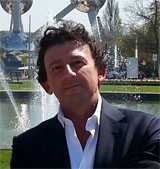A multidisciplinary approach
To address the dilemma of reddening of the asteroid spectra, research institutes and Italian universities have decided to combine their skills in the field of astronomy, spectroscopy and nanomaterials by adopting an integrated approach to the study of surfaces of extra-terrestrial materials. The initiative, coordinated by P.F. Moretti, is named ETNA.
The analysis of the spectrum of some asteroids (remotly acquired with telescopes) shows that they are more luminous in the infrared band than when they are investigated through their fragments fallen on the Earth (meteorites). From the study of meteorite surfaces, both through the use of spectroscopes and atomic force microscopes, it has been demonstrated that this phenomenon is linked to the presence of metal alloys that mainly correspond to very hard steels.
P.F. Moretti, A. Maras, E. Palomba, M. Girasole, A. Cricenti, G. Pompeo, G. Longo, F. Somma, L. Colangeli, M. Serracino, 2005, "Detection of nano-structured metal in meteorites: its implications for the reddening of asteroids”, Astrophys. Journal Letters, 634, L117
P.F. Moretti, A. Maras, L. Folco, 2007, “Space weathering, reddening and gardening of asteroids: a complex problem”, Advances in Space Research, 40, 258
